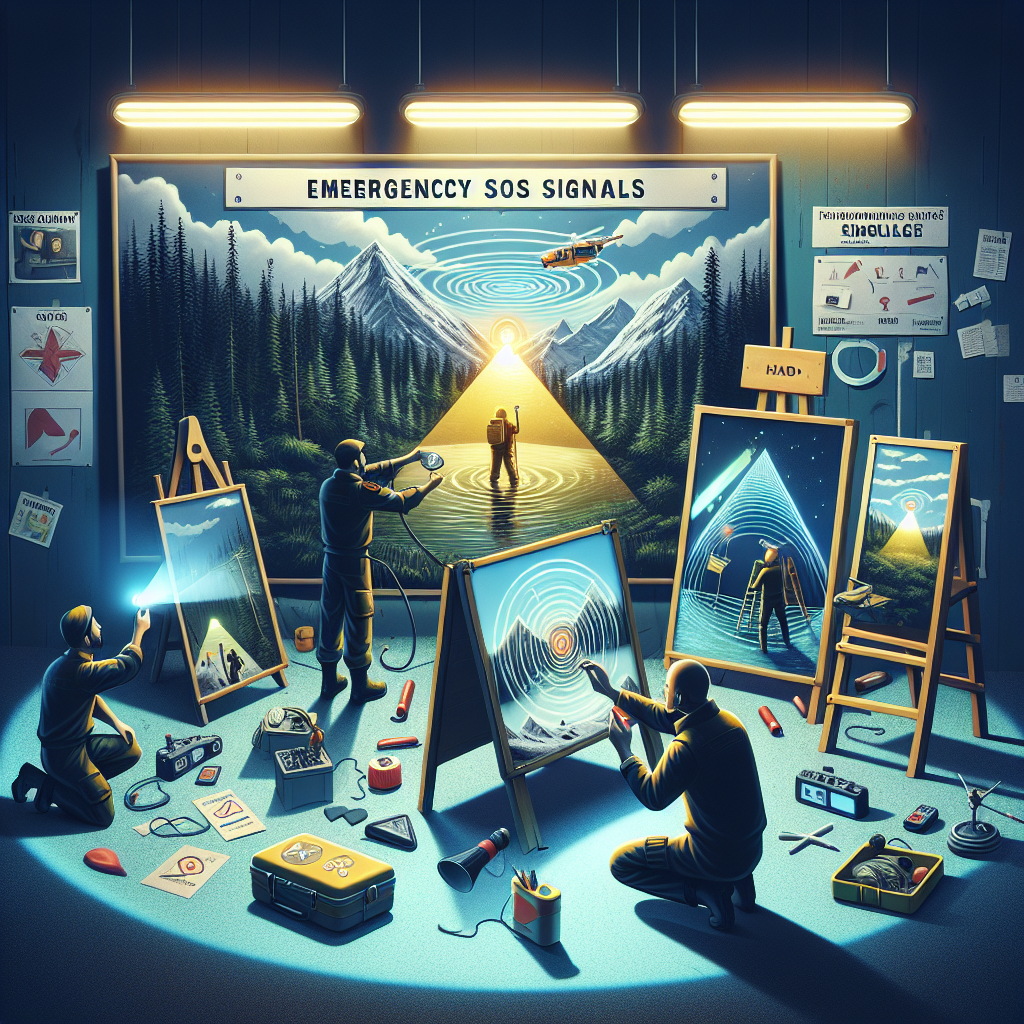In times of crisis and dire need, it is crucial to know how to effectively create an emergency SOS signal. This concise guide will provide you with simple yet powerful techniques to catch the attention of rescuers and alert them to your location. By following the steps outlined in this article, you will gain the knowledge and confidence to communicate your distress and increase your chances of being rescued swiftly and safely.
Materials and Equipment
To effectively signal for help in an emergency situation, it’s important to have the right materials and equipment. Here are some essential items to consider:
Whistle
A whistle is a simple yet powerful signaling tool. It can produce a loud, piercing sound that can travel long distances, alerting potential rescuers to your location.
Mirror
A small, lightweight mirror with a reflective surface can be used to create flashes of light that can catch the attention of search and rescue teams. By angling the mirror toward the sun or a light source, you can send a highly visible signal over long distances.
Flashlight
A flashlight with a strobe or flashing mode can be an effective visual signal, especially during nighttime or when it’s dark. The repetitive flashing of the light can attract attention and help rescuers locate you.
Flares
Flares are designed specifically for signaling in emergency situations. They emit bright, colorful lights and smoke, making them highly visible both during the day and at night.
Firestarter
Being able to build a fire is not only essential for survival but can also serve as a signal. Smoke from a well-established fire can be seen from afar, especially in open areas or during clear weather conditions.
Mobile phone or radio
Having a means of communication, such as a mobile phone or a two-way radio, can greatly increase your chances of being rescued. Make sure to keep it fully charged and protected from water or damage.
Signal flags
Signal flags are specially designed to convey messages over long distances. They typically have bright colors and easily recognizable symbols or letters.
Clothing or fabric for signaling
Bright-colored clothing or fabric can be used to create visual contrast against the surroundings, making you more visible. A brightly colored t-shirt or a reflective vest are good options.
Chemical light sticks
Chemical light sticks are portable and easy to use. They emit a bright, steady light for several hours and can be a reliable source of light during the night or in low-light conditions.
Bright-colored or reflective items
In addition to clothing, carrying bright-colored or reflective items such as a poncho, hat, or tape can provide additional visibility and increase your chances of being spotted.
Having these materials and equipment readily available and knowing how to use them effectively can significantly improve your chances of getting the attention of potential rescuers.
Choosing a Signal Location
Once you have your signaling materials ready, the next step is to find an optimal location to maximize your chances of being seen or heard. Consider the following factors when choosing a signal location:
Evaluate surroundings
Take a moment to assess your surroundings and look for potential areas that offer better visibility, such as high ground, open terrain, or areas near bodies of water.
Identify high visibility areas
Look for areas that are easily visible from a distance, such as ridges, hilltops, or areas with large, conspicuous landmarks that stand out from the surroundings.
Consider natural landmarks
Using natural landmarks, such as mountains, rivers, or lakes, can help rescuers pinpoint your location. Make sure to position yourself in a way that these landmarks are visible from the air or ground.
Look for open spaces
Open spaces, such as fields or clearings, provide a clear line of sight for rescuers. These areas make it easier for your signals to be seen or heard without obstruction.
Avoid dense vegetation
While it may provide shelter, dense vegetation can hinder your signals from reaching their intended recipients. Try to position yourself away from thick forests or dense undergrowth.
Consider line-of-sight to potential rescuers
Think about the possible vantage points from which rescuers might approach. Position yourself where you can easily be seen from those directions.
Accessible from multiple directions
Choose a location that can be easily accessed from various directions to increase the likelihood of being spotted by search teams coming from different angles.
By carefully selecting your signal location, you can greatly enhance the visibility and audibility of your distress signals, increasing the chances of getting the attention of potential rescuers.

Auditory Signals
When trying to signal for help, auditory signals can be highly effective, especially in situations where visibility may be restricted. Here are some methods for creating auditory signals:
Whistle blasts
A whistle is a compact and portable device that can produce loud, attention-grabbing sounds. Use short bursts or long and repetitive blasts to draw attention to your location.
Shouting or calling for help
If there are no signaling devices available, shouting or calling for help can still be effective. Keep your calls loud, clear, and rhythmic to attract attention.
Using a horn or siren
If you have access to a horn or a siren, use it to create a continuous or intermittent sound pattern that stands out from the surrounding noises.
Creating rhythmic noises
In the absence of other signaling devices, you can create rhythmic noises using any available materials, such as banging rocks together, tapping on a hard surface, or even clapping your hands.
Visual Signals
Visual signals are crucial for catching the attention of potential rescuers, especially during the daytime or in well-lit environments. Here are some effective visual signaling methods:
Using a mirror or reflective object
A mirror or any reflective object, such as a CD or a small piece of metal, can be angled towards the sun to create flashes of light. Sweep the reflected light across the horizon in a rhythmic pattern to increase visibility.
Flashing a light
If you have a flashlight with a strobe or flashing mode, use it to create repetitive flashes of light. This can be particularly effective at night or in low light conditions.
Setting off flares
Flares are specifically designed for signaling in emergency situations. Follow the instructions carefully and set them off in open areas to produce bright lights and smoke.
Building a fire
A well-established fire can produce a significant amount of smoke, which can be seen from afar, especially during clear weather conditions. Ensure that the fire is safe and under control.
Waving bright-colored or reflective items
Wave bright-colored or reflective items, such as clothing, flags, or fabric in a visible manner. The contrasting colors and movement will attract attention.
Using signal flags or markers
Signal flags or markers with vivid colors or recognizable symbols can be displayed or placed in highly visible locations, such as on high ground or tied to trees or stakes.
Creating a smoke signal
If you don’t have access to flares or fire-starting materials, you can still create a smoke signal by placing green vegetation or wet materials on a fire to produce thick smoke.

Using Technology for Signals
In today’s technology-driven world, there are several ways to utilize technology for signaling in emergency situations. Here are some methods:
Using a mobile phone or radio
If you have a mobile phone or a two-way radio with you, use them to contact emergency services or to communicate directly with potential rescuers. Make sure the battery is fully charged and preserve battery life by minimizing usage.
Sending distress signals via GPS
Many mobile phones and GPS devices have distress signal functions or apps that allow you to send your exact location to emergency services or pre-selected contacts. Familiarize yourself with these features and use them if available.
Utilizing emergency apps and devices
There are numerous emergency apps and devices available that can help you send distress signals, communicate your location, or provide valuable survival information. Explore and download such resources before your adventure.
Using satellite messengers
Satellite messengers, such as personal locator beacons (PLBs) or satellite communicators, can send distress signals and provide your location information to emergency services or search and rescue organizations. Make sure to register your device and carry it with you.
Creating A Symbol or Ground-to-Air Code
In certain emergency situations, it may be necessary to establish a symbol or ground-to-air code that can be easily recognized by potential rescuers. Here’s how to create a symbol or code:
Research commonly recognized symbols
Research and familiarize yourself with commonly recognized symbols used in distress signals. These symbols are often universally understood and can help convey your message more effectively.
Choose a symbol that fits your situation
Select a symbol or code that reflects your specific situation or emergency. For example, drawing a large “X” on the ground may signal distress when visible from the air, or a series of three parallel lines might denote an urgent need for medical assistance.
Make the symbol large, clearly visible, and contrasting
Ensure that the symbol or code you create is large enough to be seen from a distance and clearly visible against the background. Use contrasting colors or materials to make it stand out.
Maintain the symbol over time
Regularly check and maintain the symbol or code you create to ensure that it remains visible and recognizable. Reconstruct or refresh it if necessary, especially after severe weather conditions.
Signaling for Help
Knowing when to signal for help is crucial. Here are some considerations when signaling for help:
Knowing when to signal for help
While it’s important to remain calm and try to solve the situation yourself, there may come a point where signaling for help becomes necessary. Assess your circumstances, available resources, and the severity of the situation before deciding to signal.
Conserving energy and resources
Signal for help only when necessary to conserve energy and resources. While signaling is vital, it’s important to strike a balance to ensure you have enough resources to survive until help arrives.
Creating a signaling schedule
If you’re in an extended survival situation, create a signaling schedule to maximize your chances of being seen or heard. Determine the best times of day to signal and stick to that schedule to maintain a routine.
Using distress signals in a sequence
Using a sequence of distress signals can help convey the urgency and seriousness of your situation. Start with the most visible or audible signals and progressively use more resources as needed.
Knowing international distress signals
Familiarize yourself with international distress signals, such as the SOS signal and Mayday calls. These universal signals are widely recognized and understood, increasing the chances of a successful rescue operation.
Signaling Etiquette and Safety
When signaling for help, it’s important to follow certain etiquette and safety guidelines to avoid confusion and ensure the safety of everyone involved. Consider the following:
Standard distress signals
While it’s essential to be creative and resourceful when signaling for help, it’s equally important to use standard distress signals when appropriate. These signals are widely recognized, making it easier for rescuers to understand your situation.
Avoiding false signals
Avoid creating false or misleading signals, as this can divert resources and hinder other rescue operations. Signaling for help should only be done when there is a genuine need.
Signaling only when help is truly needed
Use your judgment and signal for help only when it’s absolutely necessary. Wasting resources or unnecessarily calling for help can have detrimental consequences for yourself and others.
Signaling responsibly and sparingly
Use your signaling devices responsibly and sparingly to avoid draining battery life or running out of resources. Prioritize your signals and use them judiciously.
Understanding potential risks
Be aware of the potential risks associated with signaling for help, such as attracting unwanted attention. Stay vigilant and maintain situational awareness to mitigate any potential dangers.
Training and Practice
Proper training and regular practice are crucial to effectively use signaling methods in emergency situations. Here are some steps to consider:
Learning different signaling methods
Take the time to learn and understand different signaling methods, including both auditory and visual signals. Familiarize yourself with the equipment and practice their usage.
Practicing in different scenarios
Simulate various emergency scenarios and practice signaling in different environments. This will help you become more proficient in adapting your signals to different conditions.
Simulating emergency situations
Organize or participate in simulated emergency scenarios to test your skills and the effectiveness of your signals. This will provide valuable hands-on experience and help identify areas for improvement.
Seeking professional training
Consider seeking professional training in survival and signaling techniques. Organizations, such as search and rescue teams or outdoor survival schools, offer courses that can enhance your abilities and knowledge.
Testing and familiarizing with equipment
Regularly test and familiarize yourself with your signaling equipment to ensure it is in working order. Confirm that batteries are charged, flares are within the expiration date, and reflectors are not damaged or obscured.
Getting Rescued
Once you have successfully signaled for help, it’s important to remain calm and prepared for the rescue operation. Here’s what you should do:
Remaining calm and patient
Stay calm and composed while waiting for help. Panicking can cloud your judgment and hinder the rescue process. Remain patient and trust that help is on the way.
Monitoring for response signals
While waiting, keep a lookout for any response signals from potential rescuers. These signals may include aircraft circling overhead or sounding horns to acknowledge your distress.
Preparing to receive help
Prepare yourself physically and mentally for the arrival of rescuers. Ensure that you can easily be reached, remove any obstacles, and gather important belongings or documents.
Cooperating and communicating with rescuers
When rescuers arrive, follow their instructions and cooperate fully. Provide them with any relevant information about your situation, injuries, or medical conditions to aid in their response.
Following post-rescue procedures
After being rescued, it’s crucial to follow any post-rescue procedures or medical assessments recommended by the rescuers. Even if you feel fine, it’s important to receive proper medical attention to address any potential hidden injuries or conditions.
Remember, signaling for help is just one part of the survival process. It’s important to remain prepared, stay calm, and use your resources wisely. By understanding the various signaling methods and following proper procedures, you can significantly increase your chances of being rescued in an emergency situation.

